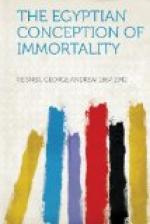Alongside these manifold manifestations of the belief in magic, other furniture—implements, weapons, and utensils—are still placed in the grave. The offering places are still maintained. All burials are now extended on the back and wrapped in bandages. Yet the common graves lack the receptacles for the viscera, lack magical texts, lack ushabtiu, and—in a word—lack all those things which are typical of the better-class graves of the period. The conception of the future life among the common people is apparently not essentially different from that of the Old Empire. But the books of the dead and the offering formulas show that the priests and high officials at death were called Osiris.
By the end of the Late Period the Osiris cult of the dead had come to be universal. No doubt political events had much to do with this. The absorption of the powers of the king by the priesthood of the national god Amon-Ra, the crushing of the nobility by a succession of foreign invaders, and the general uncertainty of life, had disturbed the old fixed relations. The hope of every Egyptian turned to a glorified future life as Osiris.
The tendency to use magical texts and symbolic objects reached its height. About 700 B.C. a revival of national life, brought about by the establishment of the Egyptian kings of Sais as kings of Egypt, led to a renaissance of Egyptian art. The old monuments were copied and imitated, the old funerary texts and offering formulas were sought out in the older graves. Even the pyramid texts reappear after one thousand years of practical oblivion. The value of master words was so firmly fixed in the Egyptian mind that misunderstood texts of all sorts were copied out and placed in the graves to secure to the dead some vague benefit in the other world.
The process of mummification was at its height. The bodies were no longer preserved. The process was merely the creation of a simulacrum of the dead Osiris So-and-So. All the perishable parts of the body were removed or destroyed by chemicals. Only the skin, bones, hair, and teeth remained to be padded with mud and resin, wrapped in cloths, covered with a painted and gilded cartonnage to represent the glorified Osiris mummy.
VIII. THE PTOLEMAIC-ROMAN PERIOD
In the Ptolemaic-Roman period we see the final stage of the Osiris cult. Every dead man is laid in his grave without furniture, prepared as a simulacrum of Osiris. The wealthiest people have gilded and painted mummy cases with amulets and funerary papyrus. The poorer are merely bundles of wrappings. Every dead man is Osiris, and no doubt carried with him words learned on earth to gain his way to a place in the kingdom of Osiris. The offering places above the grave are still made and offerings are still brought.




